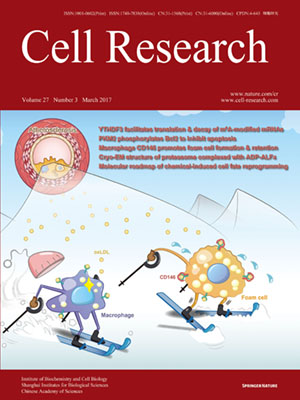
Volume 27, No 3, Mar 2017
ISSN: 1001-0602
EISSN: 1748-7838 2018
impact factor 17.848*
(Clarivate Analytics, 2019)
Volume 27 Issue 3, March 2017: 352-372 | Open Access
ORIGINAL ARTICLES
Macrophagic CD146 promotes foam cell formation and retention during atherosclerosis
Yongting Luo1,*, Hongxia Duan1,*, Yining Qian2,*, Liqun Feng2, Zhenzhen Wu1, Fei Wang1, Jing Feng1, Dongling Yang1, Zhihai Qin1 and Xiyun Yan1
1Key Laboratory of Protein and Peptide Pharmaceutical, Institute of Biophysics, Chinese Academy of Sciences, Beijing 100101, China
2Beijing Anzhen Hospital of the Capital University of Medical Sciences, Beijing 100029, China
Correspondence: Xiyun Yan, Tel: +86 10 64888583; Fax: +86 10 64888584(yanxy@ibp.ac.cn)
The persistence of cholesterol-engorged macrophages (foam cells) in the artery wall fuels the development of atherosclerosis. However, the mechanism that regulates the formation of macrophage foam cells and impedes their emigration out of inflamed plaques is still elusive. Here, we report that adhesion receptor CD146 controls the formation of macrophage foam cells and their retention within the plaque during atherosclerosis exacerbation. CD146 is expressed on the macrophages in human and mouse atheroma and can be upregulated by oxidized low-density lipoprotein (oxLDL). CD146 triggers macrophage activation by driving the internalization of scavenger receptor CD36 during lipid uptake. In response to oxLDL, macrophages show reduced migratory capacity toward chemokines CCL19 and CCL21; this capacity can be restored by blocking CD146. Genetic deletion of macrophagic CD146 or targeting of CD146 with an antibody result in much less complex plaques in high-fat diet-fed ApoE−/− mice by causing lipid-loaded macrophages to leave plaques. Collectively, our findings identify CD146 as a novel retention signal that traps macrophages within the artery wall, and a promising therapeutic target in atherosclerosis treatment.
10.1038/cr.2017.8
FULL TEXT | PDF
Browse 1837


